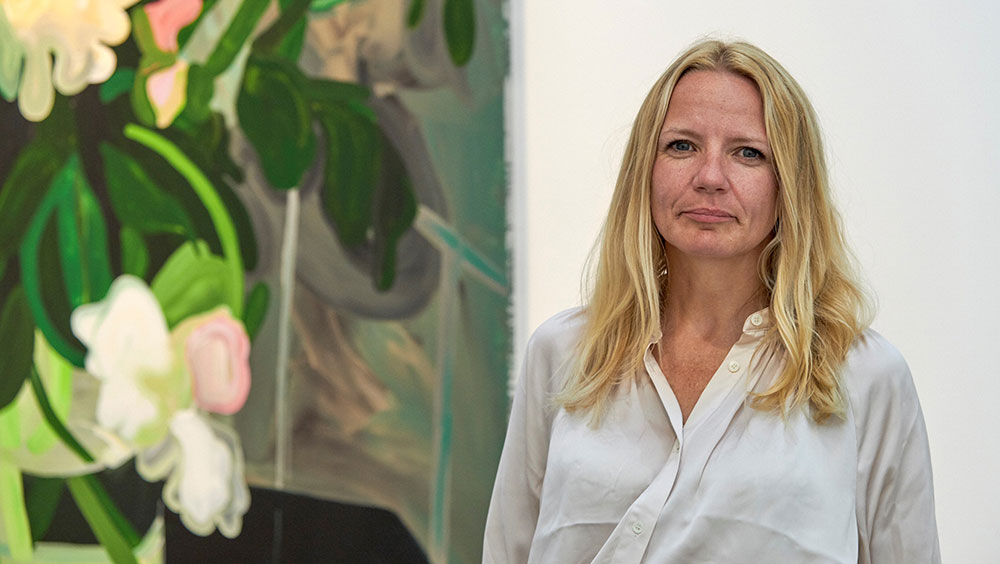
Clare Woods, 2019. Courtesy artist and Simon Lee Gallery. Photo: Ben Westoby.
by DAVID TRIGG
Initially trained as a sculptor, Clare Woods (b1972, Southampton) switched to painting early on in her career, coming to prominence in the late 90s with a series of large-scale landscapes in oil and enamel. Derived from photographs of tangled undergrowth and woodland vegetation, these enigmatic paintings with their rich, earthy palettes, have frequently drawn comparisons with the work of the British neo-romantic painters Graham Sutherland and John Piper. Despite leaving sculpture behind, Woods has continued to revel in the physicality of objects and forms through her paintings on aluminium and works on paper, which delight in the interplay between abstraction and representation. Yet it is photography to which she owes the greatest debt, since each of her works begins with a photographic image. These images, which she sources from books, magazines, the internet and her own photographs, are deconstructed and reimagined before being reinterpreted in paint, print and, most recently, collage.
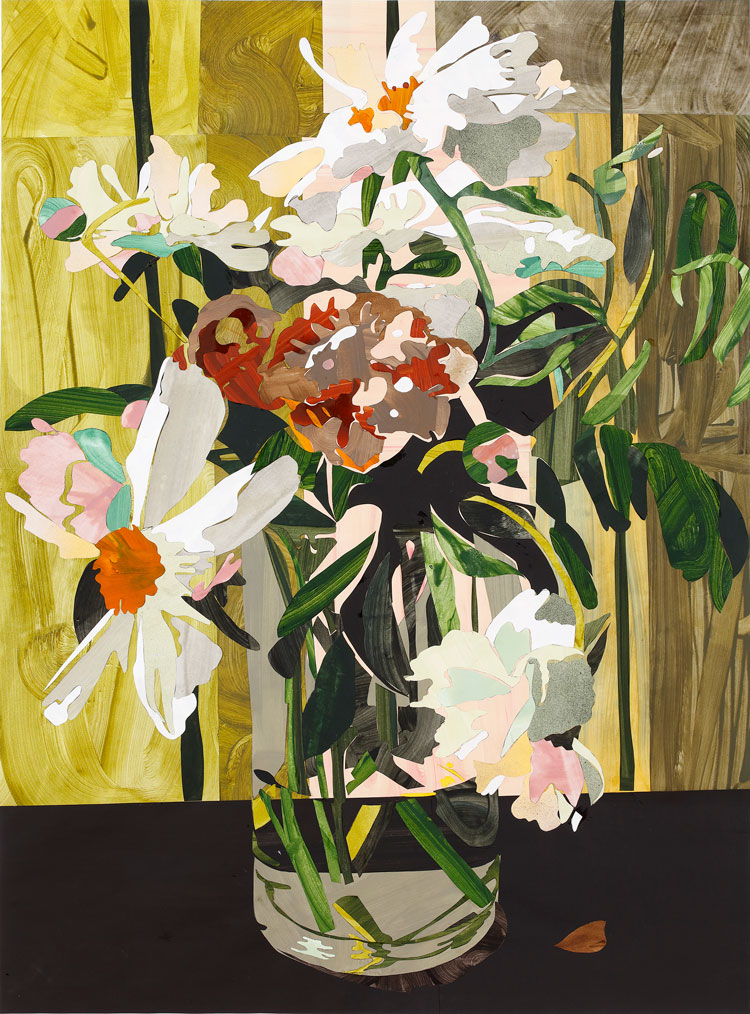
Clare Woods. Collage for It’s The End of the World As We Know It, 2020. Oil and spray paint on paper, 122 x 90 cm. Courtesy Clare Woods and Cristea Roberts Gallery, London.
For many years, Woods’ primary subject was landscape, though she has since embraced a range of genres, including portraiture and still life. The human form has become an increasingly prominent element, as have flowers, which reflect her interest in fragility, vulnerability and the fine line between sickness and health. “For me, the idea of a vase of flowers represents a lifespan, in a tiny little environment,” she has said. “You’ve got the youth of the buds and the flowers are in full bloom, before they droop and discolour, and then the petals fall off and they die. It’s the whole life cycle that I am interested in.” As with her landscapes, these new still lifes express her interest in the dualities of fecundity and decay, beauty and menace.
Such themes dominate The Great Unknown, her new exhibition at Cristea Roberts Gallery in London. Featuring screenprints, monotypes and collages, it is the first time she has shown a substantial group of works on paper. The show’s title, which was conceived before lockdown, refers to the sense of anticipation she felt during the printmaking process, as well as her unfamiliarity with the technology. “I had no idea when I named the show, back in February 2020, how significant the title could be seen to be in terms of the world we are now experiencing,” she remarked. In this interview for Studio International, Woods discusses her new prints and collages, their relationship to her paintings and the impact of the pandemic on her work.
David Trigg: What attracted you to printmaking?
Clare Woods: The more I make prints and works on paper, the more I learn about my paintings. It really informs my practice. This is particularly true of screenprinting. It is not a technique that I would naturally have chosen, but as I learned more about the process I realised it was a lot closer to how I break down images and reconstruct them in paint than I had imagined. Printmaking takes away the directness of the hand, which allows things to happen that I am not totally in control of. This loss of direct mark-making is quite scary as I like to be in control.
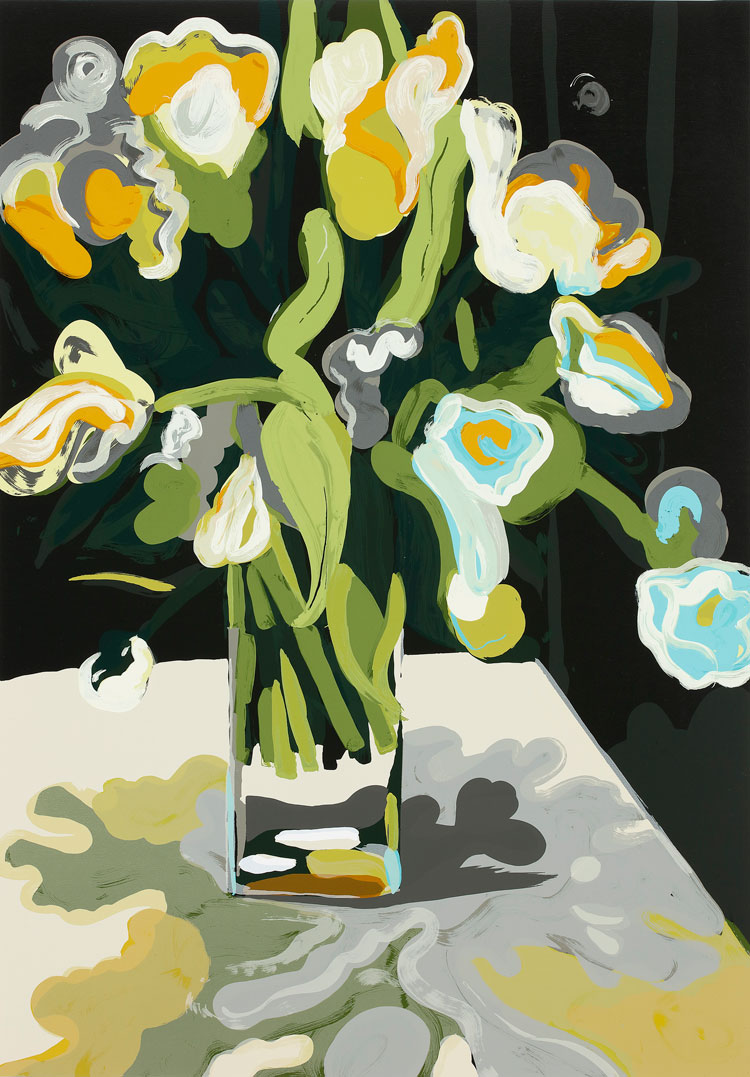
Clare Woods. Idle Hands, 2020. From set of four screenprints with woodblock, paper and image 100 x 70 cm. Courtesy Clare Woods and Cristea Roberts Gallery, London.
DT: What informed your choice of printing techniques?
CW: I have worked a lot with lithography in the past and wanted the challenge of working with two forms of printing I have had very little experience with. Monotype and screenprinting feel like two extremes – monotype being totally hands on and unique, and screenprinting feeling more detached and abstract. Monotype suited me and my mark-making very well as it felt much closer to painting. The production was quick and fast; I rolled the ink out on to the plate and then used a sock and white spirit to draw the shapes, it was all very hands on. But the screenprinting process was really difficult to get my head around. I had to deconstruct the image into 15 or 16 different colours and each layer had to be painted separately. It took a couple of visits to the printmaking studios and a few failed attempts before the penny dropped and I got into it. Breaking images down is essentially what I do in my paintings, but not to that extreme.
DT: Did you use a computer to deconstruct the images?
CW: No, everything was done by hand. I used a light box with a photograph as a guide. I made drawings and painted each one on to the film, laying one layer on top of another to work out where the colours would cross over. Although there’s a lot of preparation involved with painting, the actual execution is very quick and I usually make a painting in a day. That’s what I enjoyed about the monotypes. I found the screenprinting a lot more frustrating because I couldn’t do it all myself. Also, you have to commit, it’s very difficult to go back and make changes later. It was really slow and a steep learning curve. It took a year to make those prints.
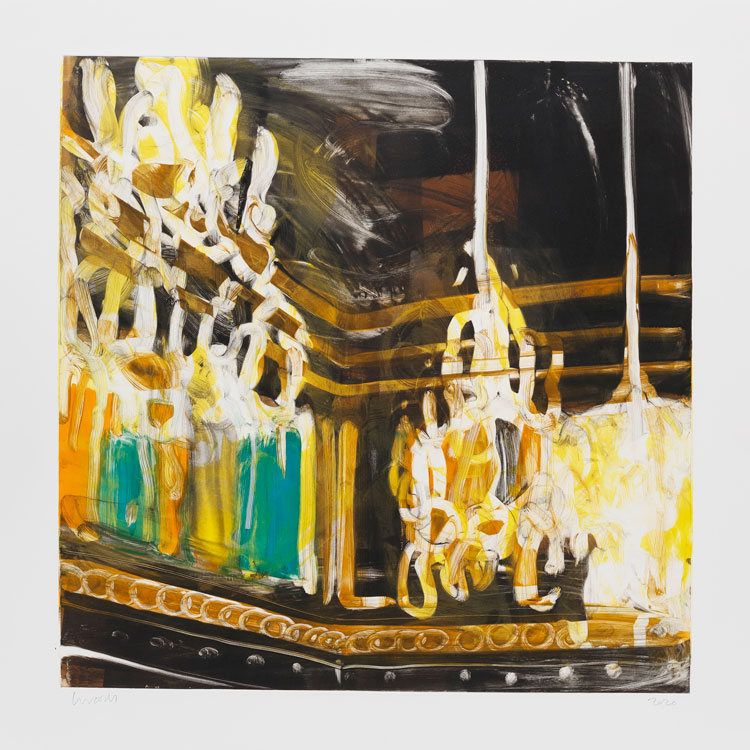
Clare Woods. Hot Spot, 2020. Monotype, paper and image 60 x 60 cm. Courtesy Clare Woods and Cristea Roberts Gallery, London.
DT: Your prints, like your paintings, are derived from photographs found in books and magazines and on the internet. What attracts you to particular images?
CW: My paintings, prints and collages cannot exist without photography. The starting point is always a photographic image, sometimes found, sometimes one I have taken myself. I have been collecting images for years. I’ve got boxes and boxes of paper images, but I’ve digitised most of them now so I just browse through those. I have no criteria for the image choice, it’s a feeling. I see an image and I know I can use it. It is really that simple.
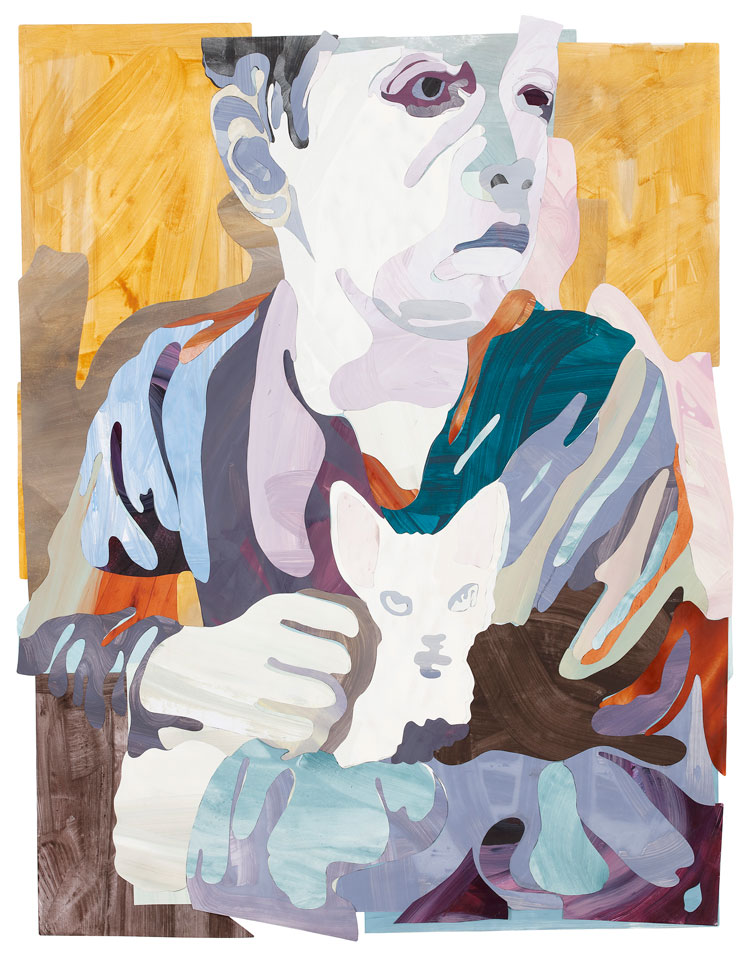
Clare Woods. Collage for the Comforters, 2020. Oil and spray paint on paper with carbon and pencil, 109 x 84.6 cm. Courtesy Clare Woods and Cristea Roberts Gallery, London.
DT: There is one image that really stands out for me in this show, Collage for the Comforters (2020). It is so full of emotion.
CW: That’s from one of my own photographs. It’s an image of my son from quite a long time ago. He wasn’t in a great place and we bought two kittens to give him something to focus on and that was just a picture of him with a cat. I was thinking of Lucian Freud’s Girl With a Kitten (1947) when I made this work. But it’s not necessary to know that. All my images, even the found ones, evoke something personal. That’s how I pick them: I feel I need to paint them and they translate something that I’m thinking about. But that knowledge isn’t needed by the viewer.
DT: You often begin with black-and-white photographs, but your paintings and prints employ complex colour relationships. What informs your colour choices?
CW: I find colour quite easy, but it’s more instinctive than considered. For instance, there’s a collage in the show called Collage for Jargon (2020), which is actually an image of my daughter. The original photograph was black and white, but I just knew the collage was going to be green. When I’m painting, I’ll mix maybe three or four main colours and add white if I want a slightly lighter tone or blue or black if I want it darker. So much of the mixing happens on the painting itself and evolves during the process, it’s not premeditated.
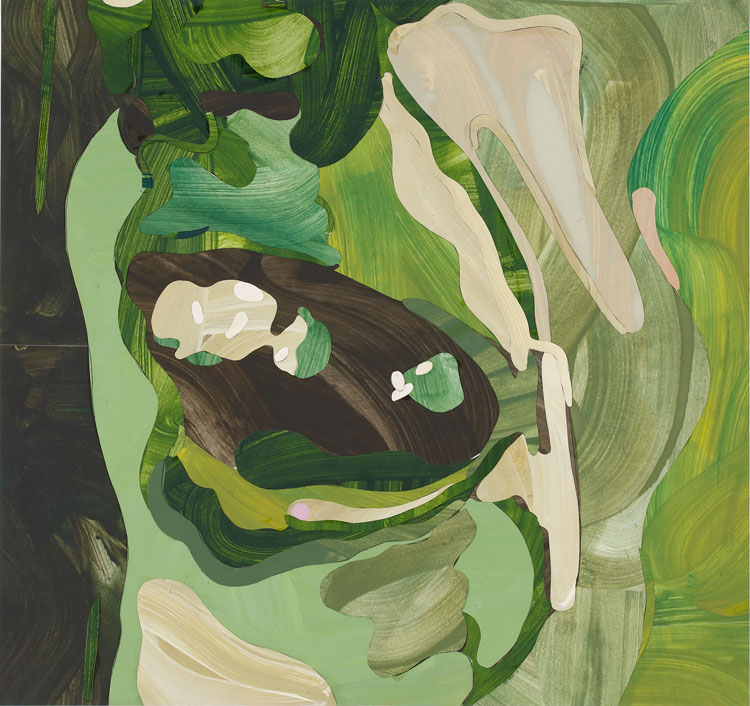
Clare Woods. Collage for Jargon, 2020. Oil and spray paint on paper, 48.8 x 51.9 cm. Courtesy Clare Woods and Cristea Roberts Gallery, London.
DT: Do you make preparatory drawings for your prints as you do for your paintings?
CW: I pretty much go through exactly the same process for the prints as I do with the paintings. I start with a photographic image that I then draw, keeping the important lines that hold the image together, but emptying it of unwanted information. I flatten and simplify it until I have just a trace of the original image. From there, I start to rebuild it, putting the detail back through the printing process.
DT: So the drawings are just functional?
CW: Absolutely, they are just part of the process of getting from the original source material to the finished image, they’re never used for anything else.
DT: What role does chance play in the creation of these works?
CW: For me, there is a space in printmaking that I call “the great unknown”, which is the title of the show. It’s a space made by the process, where things happen that I have no control over. I am not experienced enough to totally understand the technical processes so I work with print technicians who help me make the work. With screenprinting, there’s a lot of planning but, until you start seeing the proofs, you have no concept of how it all comes together. With monotype, you have to step away from structure and control and just go with the process, which is really hard for me because I’m such a control freak – I like to know how something is going to work. But when the paper is peeled back, there is always a surprise, sometimes good, sometimes not so, but always a little bit of magic.
DT What informs your titles?
CW: Like the images I collect, I’ve got thousands and thousands of titles. They come from all over the place; it might be a place name, a book, a film title, something I heard someone say on the radio, a street name, a food, song lyrics, a saying or a slogan. For me they all link to certain times, places and things, they’re not random in any way, they all have a reason. I am not a fan of descriptive titles that tell me what I am looking at, I like to offer another way into the work through a title.
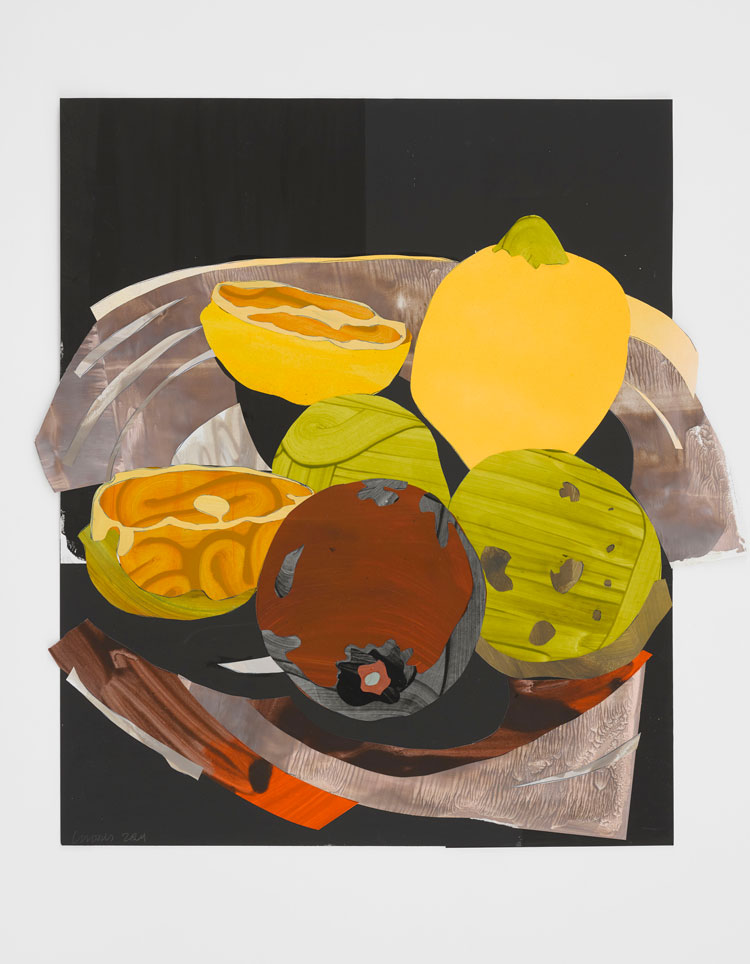
Clare Woods. Dead Already, 2019. Oil and spray paint on paper with carbon and pencil, 67.5 x 64.7 cm. Courtesy Clare Woods and Cristea Roberts Gallery, London.
DT: Several works in the show reference the Dutch vanitas genre, such as Dead Already (2019), and also your collages featuring vases of flowers. What drew you to this theme of fragility and vulnerability?
CW: Initially, my work was predominantly based on landscape and slowly moved into other painting genres and more recently still life. Fragility and vulnerability have always been with me in my work. I have had a few scrapes with my mortality and I think I realised pretty early on how fragile life is. I had an operation and hospital stay last year which is not ideal at the best of times, but during a global pandemic it is very scary. It was after this that I really started to focus on still life. I had received a lot of flowers, which I photographed every day as I was housebound. I kept photographing them until they were totally dead and had lost all their colour. I was trying to capture those moments where everything familiar felt unfamiliar and where the detail in the everyday became heightened and created a discomfort, but also allowed a way of seeing the ordinary in a different way.
DT: Covid-19 has made us all more aware of our own mortality. How has the pandemic impacted your work?
CW: This period has been incredibly productive. Most of the work was made pre-pandemic as the exhibition at Cristea Roberts should have opened in June 2020. The postponement allowed me to make more work and the gallery to produce the catalogue, so there was a silver lining. I have been very fortunate during the past year that I have been able to work alone at my studio, partly to escape the hell of home schooling and partly to close the studio door and pretend it wasn’t happening. I have never before had such intense studio time with no interruptions and long days of painting and thinking. I was working on small paintings, which allowed me to experiment and gave me more freedom to make rejects, lots of rejects.
DT: Rejects?
CW: Yes, I need to make rejects, it’s really useful. Because of the smaller scale, it was easy to scrape the aluminium panels clean and start again. I work flat and the minute I stand the paintings up I can tell whether they are working or not, but I can’t always put my finger on why, so I photograph them and later, when I come back to the image, I’ll see what’s wrong.
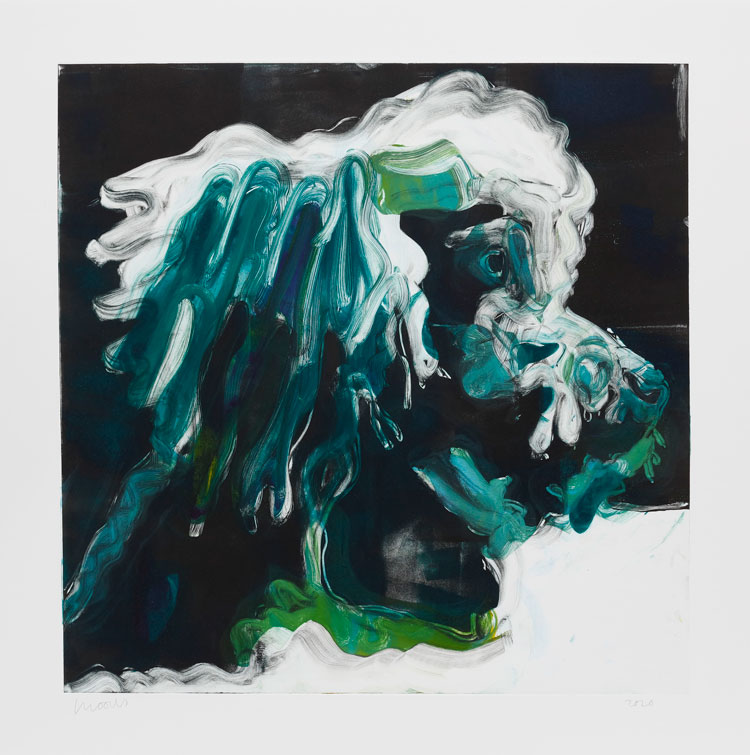
Clare Woods. Unlovable, 2020. Monotype, paper and image 60 x 60 cm. Courtesy Clare Woods and Cristea Roberts Gallery, London.
DT: When did you start making the collages?
CW: I was very fortunate to be given a month’s residency at CCA Andratx, Mallorca, in 2014. I knew I could not take aluminium panels and all the materials I need to make my paintings, so I filled a large suitcase with paper, oil paint and brushes and found a local hardware store when I arrived to buy white spirit and spray paint. It was amazingly liberating having such limited resources. I started spraying and painting papers and, because of the heat – around 38C most days – the paint was drying very fast, which allowed me to work with it quickly and directly. That was the start of the collages. After my return, they went a little on the back burner, but I realised I could continue to make the coloured papers, using diluted oil paint left over from my paintings. So I have been painting these papers for a long time and filing them in boxes according to colour. When the conversation started about this exhibition, I knew this was the chance to focus on and develop the collages.
DT: How do the collages relate to your paintings? Do they inform each other?
CW: All of the collages are made using the same source material as the paintings. They’re like companion pieces. I don’t ever repaint the same source material again, I paint it once and then it’s done. But by making the collages I was revisiting images in a different way, working with them over a long period of time, deconstructing and reconstructing them. It has really helped to inform my painting practice, allowing me to deconstruct the paintings to see what works and what does not, the faults and the successes.
DT: You have said that you think three-dimensionally as an artist, approaching image-making with a sculptor’s eye. Do you consider the collages to be images or objects?
CW: I see the collages as somewhere in between image and object. The production and construction are three dimensional, but the finished piece can work as a flat image. Although, when you experience them in the gallery, you see the layering, gaps, pencil marks and raised edges of the paper, which create shadows and emphasise it as an object.
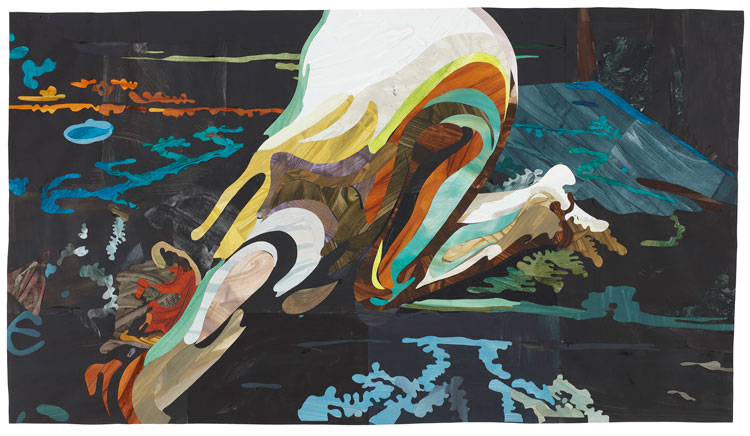
Clare Woods. Collage for Consciously Contemplate, 2020. Oil and spray paint on paper, 91 x 160.4 cm. Courtesy Clare Woods and Cristea Roberts Gallery, London.
DT: Works such as Collage for Consciously Contemplate (2020) appear fairly complex. Do the collages take a long time to produce?
CW: The way the collages are constructed is slow and laborious, the opposite to how I make my paintings. Each colour and direction of the brushmark is considered before being drawn, cut, numbered and stuck together. I worked on them with my assistant. She does all the cutting out for me with a scalpel. Some of the collages contain more than 1,000 pieces and they take weeks and weeks to complete. It is really labour intensive. I could have made an entire painting show in the time that this collage took to make.
DT: Do you intend to develop them further?
CW: Yes, definitely. At the moment I’m painting, but I’m thinking that this winter, when it gets cold in the studio, I’ll retreat into the warm and work on paper again.
• Clare Woods: The Great Unknown is at Cristea Roberts Gallery, London, until 19 June 2021.